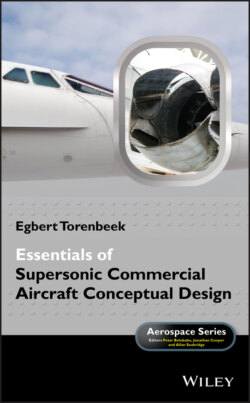Читать книгу Essentials of Supersonic Commercial Aircraft Conceptual Design - Egbert Torenbeek - Страница 19
1.6.3 Block Speed, Productivity, and Complexity
ОглавлениеThe block time for intercontinental supersonic flight rapidly improves through the low Mach number region; it levels out at speeds above Mach 3.0. Greater speeds will not be paid off with appreciable time saving to the passenger as well as increased productivity to the airliner, and the cost of cruising faster than Mach 2.0 can be large since it complicates the airframe and systems development effort. In particular, the structure of a high Mach number aircraft is subject to kinetic heating of the airframe skin. This requires a complicated air conditioning system and the usage of expensive heat‐resisting structural materials, whereas the combination of materials having different coefficients of expansion may increase structural stresses.
Complicated variable‐geometry engines are required when flying at high Mach numbers and, since the best cruise altitude increases as well, the installed power plant becomes heavier and more costly. Moreover, a heavier fuselage structure is required to cope with the higher cabin pressure differential and increased fuel tank pressurization to prevent fuel boil‐off.
A cruise speed lower than Mach 2.0 leads to less wing sweep than Concorde's leading edge sweep, which is better suited to low speed operation, higher bypass ratio engines that reduce take‐off noise, and cruise altitudes that reduce global impact of emissions. A cruise speed of Mach 1.6 to Mach 1.8 offers a practical possibility for increasing the block speed to about twice that of present‐day jetliners.
These considerations demonstrate that a considerable development effort is required to combine the need for high fuel efficiency in supersonic cruising flight with acceptable development costs and friendliness to the airfield environment during take‐off, climb‐away, approach, and landing. This means a major dilemma for the design team of any SST: there is a fundamental discrepancy between design characteristics acting in favor of efficient high‐speed cruising and acceptable flight characteristics at subsonic speeds, in particular take‐off and landing. A solution may be immanent in a market analysis indicating the effect of increasing the block speed on the aircraft's productivity and economy on a particular route network.
The industrial activities aimed at development of new SCT applications were concentrated in the time frame 1960–1990 but, in spite of the long history of technological research and development on civil supersonic aircraft, little systematic information required to initiate a realistic conceptual design of a supersonic transport or executive jet has been published. Remarkable exceptions are Corning's textbook [2] appearing first in 1960 with later versions up to 1976, and [3] published in 1978. Küchemann's authoritative book is dedicated to the aerodynamic design of transport aircraft in general and Concorde's aerodynamic development in particular.
The Concorde would not be able to successfully comply with the requirements of commercial air transport in the 21st century but with the present‐day technologies a much more efficient supersonic transport than the Concorde could be built. Many projects have been started to investigate the viability of a second generation SCT, resulting in a wealth of articles written by investigators from all continents, together forming a deluge for (teams of) engineers who are supposed to create a design concept based on a realistic set of top level requirements. It is the intention of the present author to present a synthesis of classical analysis models as well as methodologies generated by recent technological research and project studies that can be considered as an essential guidance to conceive an initial configuration design.
